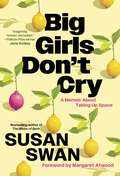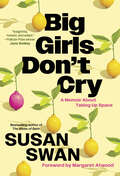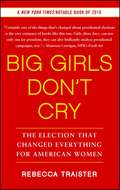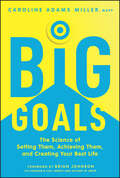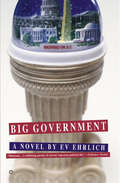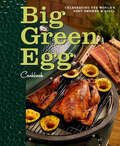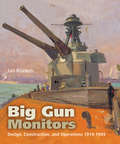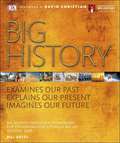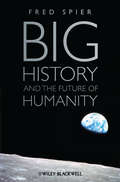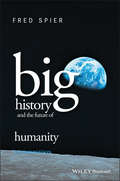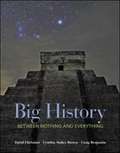- Table View
- List View
Big Gin: The Rebirth of One of the World’s Oldest Spirits
by Emanuele MensahEverything the connoisseur could ever want to know about gin, the spirit that sparked a worldwide distilling boom.Nothing communicates elegance and refinement like a Martini. Nothing refreshes on a warm summer day like a Gin & Tonic. It is no accident that gin stands at the center of these iconic cocktails, as its bold, unique character leaves a lasting impression everywhere it appears. Big Gin is the definitive exploration into this beloved spirit, tracing its history from London&’s Gin Craze to the recent renaissance that sparked a worldwide distilling boom.Aficionados will find their appreciation for their favorite varieties deepened and discover new varieties to fall in love with, while the cocktail connoisseur will uncover innovative craft offerings that are pushing the spirit in exciting directions.Inside you&’ll find:The history of ginA breakdown of the botanicals that lend gin its unique characterAn in-depth exploration of the predominant style, London dryProfiles of Hendrick&’s, Tanqueray, Beefeater, and other major playersInterviews with the master distillers who are both preserving tradition and pushing the spirit forwardRecipes for the perfect Martini, Gin & Tonic, Negroni, and other beloved gin-based cocktails
Big Girl: How I Gave Up Dieting and Got a Life
by Kelsey MillerA hilarious and inspiring memoir about one young woman's journey to find a better path to both physical and mental health. At twenty-nine, Kelsey Miller had done it all: crash diets, healthy diets, and nutritionist-prescribed "eating plans," which are diets that you pay more money for. She'd been fighting her un-thin body since early childhood, and after a lifetime of failure, finally hit bottom. No diet could transform her body or her life. There was no shortcut to skinny salvation. She'd dug herself into this hole, and now it was time to climb out of it. With the help of an Intuitive Eating coach and fitness professionals, she learned how to eat based on her body's instincts and exercise sustainably, without obsessing over calories burned and thighs gapped. But, with each thrilling step toward a healthy future, she had to contend with the painful truths of her past. BIG GIRL chronicles Kelsey's journey into self-loathing and disordered eating-and out of it. This is a memoir for anyone who's dealt with a distorted body image, food issues, or a dysfunctional family. It's for the late-bloomers and the not-yet-bloomed. It's for everyone who's tried and failed and felt like a big, fat loser. So, basically, everyone.
Big Girls Don't Cry: A Memoir About Taking Up Space
by Susan Swan“[Swan’s writing offers] not only an enjoyable read, but also the chance to think and reflect on the vast complex living entity that is the world." —Nobel Prize-winner Olga TokarczukWhere do we belong if we don’t fit in?A memoir about what it means to defy expectations as a woman, a mother and an artist, for readers of Joan Didion and Gloria Steinem and listeners of the podcast Wiser than MeSusan Swan has never fit inside the boxes that other people have made for her—the daughter box, the wife box, the mother box, the femininity box. Instead, throughout her richly lived, independent decades, she has carved her own path and lived with the consequences.In this revealing and revelatory memoir, Swan shares the key moments of her life. As a child in a small Ontario town, she was defined by her size—attracting ridicule because she was six-foot-two by the age of twelve. She left her marriage to be a single mother and a fiction writer in the edgy, underground art scene of 1970s Toronto. In her forties, she embraced the new freedom of the Aphrodite years. Despite the costs to her relationships, Swan kept searching for the place she fit, living in the literary circles of New York while seeking pleasure and spiritual wisdom in Greece, and culminating in the hard-won experience of true self-acceptance in her seventies.Swan examines the expectations of women of her generation and beyond using the lens of her then-unusual height as a metaphor for the way women are expected not to take up space in the world. Inspiring and thought-provoking, Big Girls Don’t Cry invites us to re-examine what we’ve been taught to believe about ourselves and ask how it could be different.
Big Girls Don't Cry: A Memoir About Taking Up Space
by Susan Swan&“[Swan's writing offers] not only an enjoyable read, but also the chance to think and reflect on the vast complex living entity that is the world." —Nobel Prize-winner Olga Tokarczuk Where do we belong if we don't fit in? A memoir about what it means to defy expectations as a woman, a mother and an artist, with a foreword from award-winning writer Margaret AtwoodSusan Swan has never fit inside the boxes that other people have made for her—the daughter box, the wife box, the mother box, the femininity box. Instead, throughout her richly lived, independent decades, she has carved her own path and lived with the consequences.In this revealing and revelatory memoir, Swan shares the key moments of her life. As a child in a small Ontario town, she was defined by her size—attracting ridicule because she was six-foot-two by the age of twelve. She left her marriage to be a single mother and a fiction writer in the edgy, underground art scene of 1970s Toronto. In her forties, she embraced the new freedom of the Aphrodite years. Despite the costs to her relationships, Swan kept searching for the place she fit, living in the literary circles of New York while seeking pleasure and spiritual wisdom in Greece, and culminating in the hard-won experience of true self-acceptance in her seventies.Swan examines the expectations of women of her generation and beyond using the lens of her then-unusual height as a metaphor for the way women are expected not to take up space in the world. Inspiring and thought-provoking, Big Girls Don&’t Cry invites us to re-examine what we've been taught to believe about ourselves and ask how it could be different.
Big Girls Don't Cry: The Election that Changed Everything for American Women
by Rebecca TraisterJournalist and Salon writer Rebecca Traister investigates the 2008 presidential election and its impact on American politics, women and cultural feminism. Examining the role of women in the campaign, from Clinton and Palin to Tina Fey and young voters, Traister confronts the tough questions of what it means to be a woman in today's America.The 2008 campaign for the presidency reopened some of the most fraught American conversations--about gender, race and generational difference, about sexism on the left and feminism on the right--difficult discussions that had been left unfinished but that are crucial to further perfecting our union. Though the election didn't give us our first woman president or vice president, the exhilarating campaign was nonetheless transformative for American women and for the nation. In Big Girls Don't Cry, her electrifying, incisive and highly entertaining first book, Traister tells a terrific story and makes sense of a moment in American history that changed the country's narrative in ways that no one anticipated. Throughout the book, Traister weaves in her own experience as a thirtysomething feminist sorting through all the events and media coverage--vacillating between Hillary Clinton and Barack Obama and questioning her own view of feminism, the women's movement, race and the different generational perspectives of women working toward political parity. Electrifying, incisive and highly entertaining, Big Girls Don't Cry offers an enduring portrait of dramatic cultural and political shifts brought about by this most historic of American contests.
Big Girls Don't Whine: Getting On With the Great Life God Intends
by Jan SilviousNo one wants to be labeled a whiner, but many of us go through life with a "poor me," victim mentality that sounds a whole lot like whining. God never intended for us to act like "little girls," says Jan Silvious. His goal is for each of us to live as "big girls"-mature Christian women-who are capable of enjoying the richness of life He has planned.In Big Girls Don't Whine, Jan helps women: Move beyond the past and on to healthy relationships, Choose to be proactive rather than let life just "happen,"Discover their full potential,And become everything He made them to be.So how can we tell if we're living life as an immature 'little girl" or a confident "big girl?"A little girl...Is insecureBecomes the victim of circumstancesSays "I can't"ManipulatesA big girl...Is secureRests in God's sovereigntySays, "I can"CommunicatesIn Big Girls Don't Whine, Jan Silvious calls us to be real women in a real world, free to experience a life of full of potential and vision. This book is the how-to manual for making it happen.
Big Goals: The Science of Setting Them, Achieving Them, and Creating Your Best Life
by Caroline Adams MillerEverything you need to make your goals a reality Big Goals: The Science of Setting Them, Achieving Them, and Creating Your Best Life delves deeply into effective goal setting practices for both personal growth and corporate excellence, empowering individuals across all ages to pursue their ambitions with a newfound sense of confidence and mastery. Readers of this book will gain a nuanced understanding of the little-known science of goal setting, with practical tools and unique worksheets to use on their goal-achieving journey. The insight in this book is powered by 15 years of exciting findings of positive psychology, along with Caroline Adams Miller's extensive experience as an executive coach. In this book, readers will learn about: The newest science on mindset, grit, Artificial Intelligence, resilience, and gender perspectives Miller's novel BRIDGE methodology, which addresses the “how” between the assignment of Objectives and Key Results (OKRs) and Key Performance Indicators (KPIs) Locke and Latham's Goal Setting Theory (GST) and why it has been proven to work so well No matter whether you're scared to start, sick of failure, or somewhere in between, Big Goals explains the new approach you need to more confidently and effectively move forward towards achieving your goals in your personal and professional life.
Big Gods: How Religion Transformed Cooperation and Conflict
by Ara NorenzayanA groundbreaking account of how religion made society possibleHow did human societies scale up from tight-knit groups of hunter-gatherers to the large, anonymous, cooperative societies of today—even though anonymity is the enemy of cooperation? How did organized religions with "Big Gods"—the great monotheistic and polytheistic faiths—spread to colonize most minds in the world? In Big Gods, Ara Norenzayan makes the surprising argument that these fundamental puzzles about the origins of civilization answer each other.Sincere faith in watchful Big Gods unleashed unprecedented cooperation within ever-expanding groups, yet at the same time it introduced a new source of potential conflict between competing groups. And in some parts of the world, societies with atheist majorities—some of the most cooperative and prosperous in the world—have climbed religion's ladder, and then kicked it away.Big Gods answers fundamental questions about the origins and spread of world religions and helps us understand the rise of cooperative societies without belief in gods.
Big Government
by Everett M. EhrlichIn this hilarious, scathing, and passionate novel of politics gone haywire, Ev Ehrlich tells the story of an innocent in wonderland, of the woman he falls in love with, and of players, politicians, and panderers of all shapes and sizes. Here is a Washington as seen through the lens of a Twain, Heller, or Christopher Buckley, but with an insider's knowledge of just how outrageous -- and, thankfully, just how irrelevant -- the government can be.
Big Government, High Debt, and Fiscal Adjustment in Small States
by Stephanie Medina Cas Rui OtaA report from the International Monetary Fund.
Big Green Egg Cookbook: Celebrating the World's Best Smoker & Grill
by Lisa MayerOver 160 recipes designed specifically for the ceramic kamado cooker, the Big Green Egg, for searing, grilling, smoking, roasting, and baking.The Big Green Egg Cookbook is the first cookbook specifically celebrating this versatile ceramic cooker. Available in five sizes, Big Green Egg ceramic cookers can sear, grill, smoke, roast, and bake. Here is the birthday gift EGGheads have been waiting for, offering a variety of cooking and baking recipes encompassing the cooker's capabilities as a grill, a smoker, and an oven.The book's introduction explains the ancient history of ceramic cookers and the loyal devotion of self-proclaimed EGGheads to these dynamic, original American-designed cookers. Complete with more than 160 recipes, 100 color photographs, and as many clever cooking tips, the Big Green Egg Cookbook is a must for the more than 1 million EGG owners in the United States and a great introduction for anyone wanting to crack the shell of EGGhead culture.
Big Green Egg Cookbook: Celebrating the World's Best Smoker & Grill
by Lisa MayerOver 160 recipes designed specifically for the ceramic kamado cooker, the Big Green Egg, for searing, grilling, smoking, roasting, and baking.The Big Green Egg Cookbook is the first cookbook specifically celebrating this versatile ceramic cooker. Available in five sizes, Big Green Egg ceramic cookers can sear, grill, smoke, roast, and bake. Here is the birthday gift EGGheads have been waiting for, offering a variety of cooking and baking recipes encompassing the cooker's capabilities as a grill, a smoker, and an oven.The book's introduction explains the ancient history of ceramic cookers and the loyal devotion of self-proclaimed EGGheads to these dynamic, original American-designed cookers. Complete with more than 160 recipes, 100 color photographs, and as many clever cooking tips, the Big Green Egg Cookbook is a must for the more than 1 million EGG owners in the United States and a great introduction for anyone wanting to crack the shell of EGGhead culture.
Big Green Egg Feasts: Innovative Recipes to Cook for Friends and Family
by Tim Hayward"Cooking on the Big Green Egg is an all-round experience... I view it as an oven that just happens to live in the garden that can do all the things a conventional oven does, plus much more. There’s nothing else quite like it." – Tom KerridgeThe Big Green Egg has been a phenomenon in the world of outdoor cooking, with a devoted following and high-end reputation. This is not just a brilliant BBQ, this is the most versatile and exciting bit of cooking kit there is. Not only can you cook on the griddle, oven roast, smoke, bake, or leave to 'low and slow', but you can treat it like a konro, mangal, forno, parilla, comal, tandoor or hāngi and create a plethora of international dishes of restaurant quality. Master Fish Tacos for friends and family, rustle up a Chicken Balti for a cosy night in, present Bistecca Fiorentina for a Tuscan feast, or serve up a Couscous Royale for a balmy summer evening. And with the expert guidance of award-winning food writer Tim Hayward, you’ll be making exceptional dishes all year round. The EGG and this cookbook will encourage you to never look at cooking the same way again. The EGG can be the linchpin of a memorable outdoor event, giving you the confidence to cook beyond your normal repertoire and create an occasion – whether it’s a special dinner for two or a celebration for many.
Big Green Purse: Use Your Spending Power to Create a Cleaner, Greener World
by Diane MaceachernProtecting our environment is one of the biggest issues facing our planet today. But how do we solve a problem that can seem overwhelming-even hopeless? As Diane MacEachern argues in Big Green Purse, the best way to fight the industries that pollute the planet, thereby changing the marketplace forever, is to mobilize the most powerful consumer force in the world-women. MacEachern's message is simple but revolutionary. If women harness the "power of their purse" and intentionally shift their spending money to commodities that have the greatest environmental benefit, they can create a cleaner, greener world. Spirited and informative, this book: - targets twenty commodities-cars, cosmetics, coffee, food, paper products, appliances, cleansers, and more-where women's dollars can make a dramatic difference; - provides easy-to-follow guidelines and lists so women can choose the greenest option regardless of what they're buying, along with recommended companies they should support; - encourages women to spend wisely by explaining what's worth the premium price some green products cost, what's not, and when they shouldn't spend money at all; and - differentiates between products that are actually "green" and those that are simply marketed as "ecofriendly." Whether readers want to start with small changes or are ready to devote the majority of their budget to green products, MacEachern offers concrete and immediate ways that women can take action and make a difference. Empowering and enlightening, Big Green Purse will become the "green shopping bible" for women everywhere who are asking, "What can I do? "
Big Gun Battles: Warship Duels of the Second World War
by Robert C. SternThis naval history of WWII explores the advancing technology and tactics of battleships through a fascinating survey of ship-to-ship duels. While many naval battles of the Second World War were decided by the torpedo or the aerial bomb, there was a surprising number of traditional ship-to-ship engagements involving the big guns of battleships and cruisers. Big Gun Battles recounts some of the most significant and technically fascinating of these gunfire duels in a narrative that combines lively storytelling with an in-depth understanding of the factors influencing victory or defeat. Covering all theatres of the naval war from 1939 until the Japanese surrender, the selected incidents demonstrate the changing face of surface warfare under the influence of rapidly improving fire-control systems, radar, and other technologies. By 1945, battleships achieved the pinnacle of gunnery excellence.
Big Gun Monitors: Design, Construction, and Operations 1914-1945
by Ian Buxton&“Extremely well researched . . . a total account of the design, building, service, refits, and fates of the big gun monitors built for WW1 and WW2.&” —Malcolm Wright, author of British and Commonwealth Warship Camouflage of WWII In the history of naval warfare probably no type of ship has provided more firepower per ton than the monitor—indeed they were little more than a huge gun mounting fitted on a simple, self-propelled raft. Designed and built rapidly to fulfil an urgent need for heavy shore-bombardment during World War I, they were top secret in conception, and largely forgotten when the short-lived requirement was over. Nevertheless, they were important ships, which played a significant role in many Great War campaigns and drove many of the advances in long-range gunnery later applied to the battle fleet. Indeed, their value was rediscovered during the Second World War when a final class was built. Monitors were largely ignored by naval historians until Ian Buxton produced the first edition of this book in 1978. Although published privately, this became an established classic and copies of the first edition are now almost unobtainable, so this new edition will be welcomed by many. It has been completely revised, extended and redesigned to a generous large format which allows material deleted from the original edition for lack of space to be restored.&“This book looks in detail at the technical and economic aspects of the 42 monitors built, and is, without a doubt, the definitive work on the subject.&” —Ships Monthly&“Ian Buxton&’s work has set the standard in celebrating these big gun ships . . . It makes an invaluable contribution to the study of naval and land operations.&” —Warships International
Big Guns and Brave Men
by Rodney Earl WaltonAlthough it was the largest and final battle of the Pacific War, the Battle for Okinawa has long been overshadowed by other dramatic events in 1945. The books that have been written about it emphasize the role of infantrymen, armor, and U.S. Marines. This work takes a fresh perspective and focuses on the vital role played by the U.S. Army's forward artillery observers-the eyes and ears of American artillery who were among the least recognized heroes of the war. According to Rodney Earl Walton, U.S. artillerymen matched Japanese gunners in intensity and surpassed them in effectiveness because their forward observers were able to provide a much shorter response time to requests for artillery support. Divided into teams consisting of four or five men led by an artillery lieutenant, these observers would spend three days on the front lines directing artillery against enemy positions, return to their artillery battery for three days, and then rotate up to the line of battle again. While trying to maximize the damage inflicted on the enemy, the men had to deal with the ever-present possibility of firing on their own forces. The ability to shift artillery fire throughout the battlefield was a new development in World War II, and its evolution is fully examined in the book. Walton, the son of one of the forward observers on Okinawa, spent more than twenty years investigating what happened to his father and other artillerymen during the conflict. Interviews with the artillerymen and the infantrymen they supported are central to his story, which is filled with gripping and sometimes humorous accounts of what happened. The work stands as a stirring tribute from the "baby boom generation" to the "greatest generation."
Big Guns: Artillery on the Battlefield (Casemate Short History)
by Angus KonstamA concise, illustrated introduction to artillery from medieval times to the modern era. Over seven centuries, the artillery piece has evolved from a status symbol to one of the most deadly weapons wielded by man. Using gunpowder weapons was initially something of a black art, but over time, gunnery became a science, a dependable method of breaching fortifications or overcoming an enemy on the battlefield. By the nineteenth century, most European armies had artillery units manned with trained gunners; Napoleon, originally an artillery officer, then took the use of artillery to a new level. Over the following decades, rapid advances in gun technology paved the way for the devastatingly powerful heavy artillery that literally transformed the landscape during World War I. The use of rolling and box barrages shaped how armies fought on the front lines, and powerful naval guns dictated the outcome of battles at sea. By World War II, the range of artillery had expanded to include self-propelled guns and powerful antitank and antiaircraft guns. In this informative introduction, historian Angus Konstam concisely explains how the development and evolving deployment of artillery led to big guns becoming the key to victory in two world wars and a potent force on the modern battlefield.
Big Hair and Plastic Grass: A Funky Ride Through Baseball and America in the Swinging '70s
by Dan EpsteinA wild pop-culture history of baseball’s most colorful and controversial decade, the 70s: “A trove of nuggets many of us either never knew . . . or forgot.” —The New York TimesThe Major Leagues witnessed more dramatic stories and changes in the 1970s than in any other era. The American popular culture and counterculture collided head-on with the national pastime, rocking the once-conservative sport to its very foundations. Outspoken players embraced free agency, openly advocated drug use . . . and even swapped wives.Controversial owners such as Charlie Finley, Bill Veeck, and Ted Turner introduced Astroturf, prime-time World Series, garish polyester uniforms, and outlandish promotions such as Disco Demolition Night. Hank Aaron and Lou Brock set new heights in power and speed while Reggie Jackson and Carlton Fisk emerged as October heroes and All-Star characters like Mark “The Bird” Fidrych became pop icons.For the millions of fans who grew up during this time, and especially those who cared just as much about Oscar Gamble’s afro as they did about his average, Dan Epstein’s Big Hair serves up a delicious, Technicolor trip down memory lane.
Big Heart Little Stove: Bringing Home Meals & Moments from The Lost Kitchen
by Erin FrenchInstant #1 New York Times Bestseller! Big Heart Little Stove is your new go-to inspiration for cooking thoughtful and meaningful, yet refreshingly simple meals. With more than 75 recipes and her favorite hospitality “signatures,” Erin French—author of The Lost Kitchen cookbook and the New York Times-bestselling memoir Finding Freedom—invites readers to bring a piece of her beloved restaurant, The Lost Kitchen, home with them.With dishes pulled from French’s family recipe box and the menu at The Lost Kitchen, ranging from irresistible nibbles like Pecorino Puffs and Gram’s Clam Dip; to luscious soups like Golden Tomato & Peach and Potato & Lentil with Bacon and Herbs; to heaping platters of family-style salads and sides like Peach & Blackberry Salad and Green Beans with Sage, Garlic, and Breadcrumbs; to show-stopping main courses like Pickle-Brined Roast Chicken and Wednesday Night Fish Fry; to French’s favorite all-purpose kitchen staples like Kitchen Sink Pesto and Floral Vinegar, this cookbook has all the tools you need for assembling a seamlessly special meal. To round things out, there are beverages to sip as dinner comes off the stove (Fresh Fruit Shrubs, Slush Puppies) and desserts to make your guests feel truly looked after (Salted Caramel Custards, Roasted Peach Pie with Almond and Fennel). And because weekend mornings deserve celebrating too, there are feel-good treats like Sunday Skillet Cakes and Little Nutmeg Diner Donuts. Regardless of whether it’s a dressed-up affair or a quick weeknight meal, French’s recommendations are the same: Start with the best ingredients you can find, keep it simple, and serve with love.But Big Heart Little Stove is more than just a cookbook. With tips and tricks French has used in her own dining room—at home and in the restaurant—this book is your invitation to use what’s around you to create meaningful moments, from setting a table with found treasures, to adorning dishes with edible flowers, to thoughtful gestures such as offering a cold cloth on a hot day. Full of warmth and spirit, Big Heart Little Stove will show you how to create more joy and connection around your table.
Big History
by DKFrom the formation of the Universe to today, countless major events have changed the course of life on Earth. Aligned with the online Big History Project supported by Bill Gates, Big History puts a wide-angle lens on 13.8 billion years of remarkable history and shows you how and why we got where we are today. With stunning visual timelines and special CGI reconstructions, you can see history's greatest events. Look back to our origins in the stars, explore everything from the birth of the Sun to modern technology, and see what the future holds for humans.Weaving together multiple disciplines including physics and sociology, and with a foreword by TED speaker Professor David Christian, Big History is a truly unique look at the history of the world.
Big History Examines Our Past Explains Our Present Imagines Our Future
by David ChristianFeaturing a foreword by the father of Big History, David Christian, and produced in association with the Big History Institute, Big History provides a comprehensive understanding of the major events that have changed the nature and course of life on the planet we call home. This first fully integrated visual reference on Big History for general readers places humans in the context of our universe, from the Big Bang to virtual reality. Why does the universe work the way it does? Why are stars so big? Why are humans so small? What does it mean to be human? Big History blends geology, biology, physics, anthropology, sociology, and so much more to tell one coherent story, taking us right back to our origins and exploring how a unique series of events led to and then impacted human existence: how everything came to be, where we fit in, and even where we are going. Graphics, artworks, timelines, and at-a-glance overviews make the causes and effects of pivotal events and major thresholds in Big History instantly accessible, and evidence features explain how we know what we know. An additional 64-page reference section provides a more conventional account of events in human history. Placing humans in the context of our universe and revealing how and why we got to where we are today, Big History covers 13.8 billion years of history, from the formation of the universe and the dawn of time to the present day.
Big History and the Future of Humanity
by Fred SpierBig History and the Future of Humanity presents an original theoretical approach that makes "big history" - the placing of the human past within the history of life, the Earth, and the Universe -- accessible to general readers while revealing insights into what the future may hold for humanity.Provides an accessible and original overview of the entire sweep of history that places human history within the history of life, the Earth, and the Universe Features an original theory of "big history" which explains all of history and opens up an entirely new interdisciplinary research agenda Offers new insights into the future of humanity by better understanding the pastPresents a new approach to complexity studies, which takes into account the greatest galaxy clusters as well as the tiniest sub-atomic particles
Big History and the Future of Humanity
by Fred SpierFeaturing a variety of updates and revisions, Big History and the Future of Humanity, Second Edition, presents an accessible and original overview of the entire sweep of history from the origins of the universe and origins of life on Earth up to the present day. Provides an accessible and original overview of the entire sweep of history that places human history within the context of the history of life, the Earth, and the universe Offers new insights into the future of humanity by providing a better understanding of the past Features a variety of updates and revisions that include increased coverage of key concepts such as the emergence of human behaviour, the development of value systems, and patterns of complexity in Big History Incorporates a variety of 'little big histories' that aid readers in recognizing how big history concepts can relate to their daily lives Instructor resources from the author will be available online upon publication Find additional resources from the author online at www.bighistory.info
Big History: Between Nothing and Everything
by David Christian Craig Benjamin Cynthia BrownBig History: Between Nothing and Everything surveys the past not just of humanity, or even of planet Earth, but of the entire universe. In reading this book instructors and students will retrace a voyage that began 13.7 billion years ago with the Big Bang and the appearance of the universe. Big history incorporates findings from cosmology, earth and life sciences, and human history, and assembles them into a single, universal historical narrative of our universe and of our place within it. <P><P> The first edition of Big History: Between Nothing and Everything, is written by the pioneers of the field, and presents a framework for learning about anything and everything. It encourages students to think critically about our cumulative history and the future of the world through a variety of lenses.


